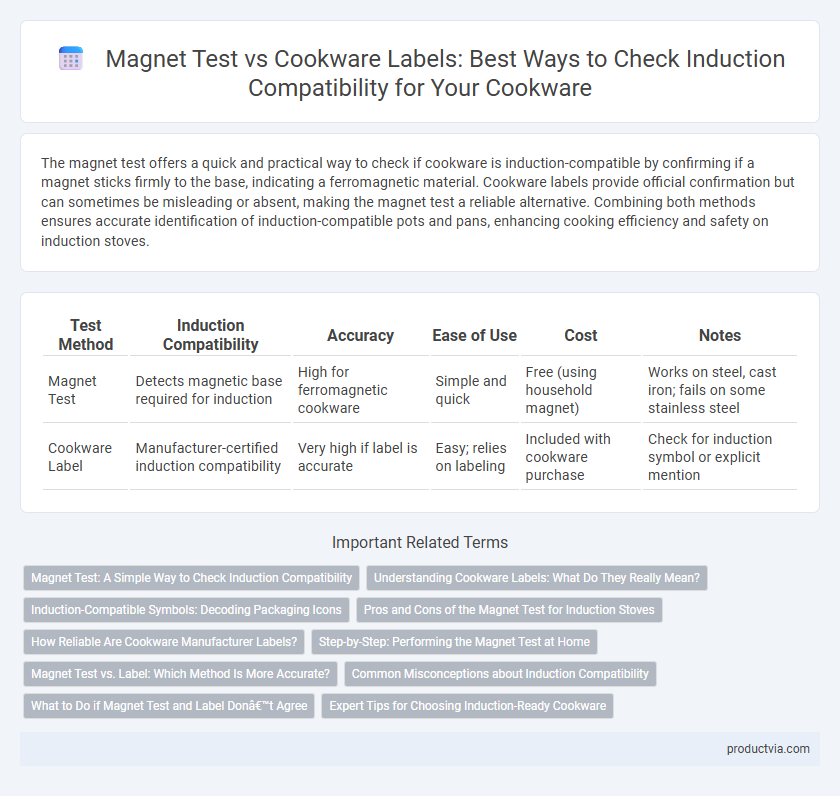The magnet test offers a quick and practical way to check if cookware is induction-compatible by confirming if a magnet sticks firmly to the base, indicating a ferromagnetic material. Cookware labels provide official confirmation but can sometimes be misleading or absent, making the magnet test a reliable alternative. Combining both methods ensures accurate identification of induction-compatible pots and pans, enhancing cooking efficiency and safety on induction stoves.
Table of Comparison
| Test Method | Induction Compatibility | Accuracy | Ease of Use | Cost | Notes |
|---|---|---|---|---|---|
| Magnet Test | Detects magnetic base required for induction | High for ferromagnetic cookware | Simple and quick | Free (using household magnet) | Works on steel, cast iron; fails on some stainless steel |
| Cookware Label | Manufacturer-certified induction compatibility | Very high if label is accurate | Easy; relies on labeling | Included with cookware purchase | Check for induction symbol or explicit mention |
Magnet Test: A Simple Way to Check Induction Compatibility
The magnet test offers a quick and reliable method to determine if cookware is compatible with induction stoves by checking the magnetic properties of the base. If a magnet sticks firmly to the bottom of the cookware, it confirms the presence of ferromagnetic material necessary for induction cooking. This simple test provides an easy alternative to relying solely on cookware labels, which can sometimes be unclear or inaccurate.
Understanding Cookware Labels: What Do They Really Mean?
Cookware labels often display symbols indicating induction compatibility, but these marks can vary between manufacturers and may not guarantee optimal performance on an induction stove. The magnet test, where a magnet is placed on the cookware base to check for magnetic attraction, offers a practical way to confirm compatibility since induction stoves require ferromagnetic materials to generate heat. Understanding that a cookware label alone may not ensure efficient induction cooking helps consumers make better choices by combining label information with simple magnet tests.
Induction-Compatible Symbols: Decoding Packaging Icons
Induction-compatible cookware is often identified by specific symbols on the packaging, such as a coil or a series of loops indicating magnetic conductivity essential for induction stoves. While the magnet test provides a quick, practical method by checking if a magnet sticks to the base, relying on official induction-compatible symbols ensures accuracy and avoids damage from incompatible materials. Understanding these packaging icons helps consumers select cookware designed for efficient heat transfer on induction cooktops, optimizing cooking performance.
Pros and Cons of the Magnet Test for Induction Stoves
The magnet test is a simple and cost-effective method to determine induction stove compatibility by checking if cookware has a magnetic base, which is essential for induction heating. However, this test can yield false positives with some ferromagnetic materials that do not heat efficiently on induction cooktops, while certain compatible cookware with non-magnetic bases may fail the test. Relying solely on the magnet test overlooks manufacturers' cookware labels specifying induction compatibility, which provide more accurate and comprehensive assurance for optimal performance on induction stoves.
How Reliable Are Cookware Manufacturer Labels?
Cookware manufacturer labels indicating induction compatibility are often helpful but not entirely reliable due to variations in magnetic properties and testing standards. The magnet test provides a practical, real-world method to verify if cookware contains sufficient ferromagnetic material to work with induction stoves. Relying solely on manufacturer labels can sometimes lead to inaccurate assumptions, making the magnet test a crucial complementary tool for confirming true induction compatibility.
Step-by-Step: Performing the Magnet Test at Home
To perform the magnet test at home, place a small magnet on the base of your cookware; if the magnet firmly sticks, the cookware is compatible with induction stoves. Cookware made from magnetic stainless steel, cast iron, or carbon steel will pass this test, while non-magnetic materials like aluminum, copper, or glass typically fail. This simple test helps verify the cookware label's declaration of induction compatibility, ensuring efficient and safe cooking performance.
Magnet Test vs. Label: Which Method Is More Accurate?
The magnet test is a quick and practical way to check induction compatibility by determining if cookware contains ferromagnetic material, which is essential for induction stovetop heating. However, cookware labels provide manufacturer-verified information that can include compatibility with specific induction technologies and wattage limits, offering a more comprehensive assessment. Despite the magnet test's simplicity, relying on the cookware label ensures accuracy in confirming compatibility and optimal performance on induction stoves.
Common Misconceptions about Induction Compatibility
Many users mistakenly believe that a magnet test alone guarantees cookware's induction compatibility, but this test only indicates the presence of ferromagnetic materials, not whether the cookware meets specific induction requirements. Cookware labeled as induction compatible has undergone rigorous testing for parameters like magnetic permeability and base thickness, ensuring efficient heat transfer and safety on induction stoves. Relying solely on magnet tests can result in poor cooking performance or damage, as some cookware may be magnetic but still incompatible with induction technology.
What to Do if Magnet Test and Label Don’t Agree
If the magnet test indicates cookware compatibility with induction but the label contradicts, verify the cookware's base material to ensure it contains ferromagnetic properties like cast iron or certain stainless steels. Conduct a test boil: place the cookware on the induction stove and check for proper heating response within a few minutes. If the cookware fails to heat despite a positive magnet test, rely on manufacturer's specifications or consider replacing the cookware with confirmed induction-compatible products.
Expert Tips for Choosing Induction-Ready Cookware
Experts recommend using a magnet test to quickly determine induction compatibility, as cookware must contain ferromagnetic materials for the stove to recognize it. While cookware labels often indicate induction readiness, some manufacturers may not provide accurate information, making the magnet test a reliable hands-on verification. Prioritize selecting pots and pans with a flat magnetic base to ensure efficient heat transfer and energy savings on induction stoves.
Magnet test vs Cookware label for induction compatibility Infographic

 productvia.com
productvia.com